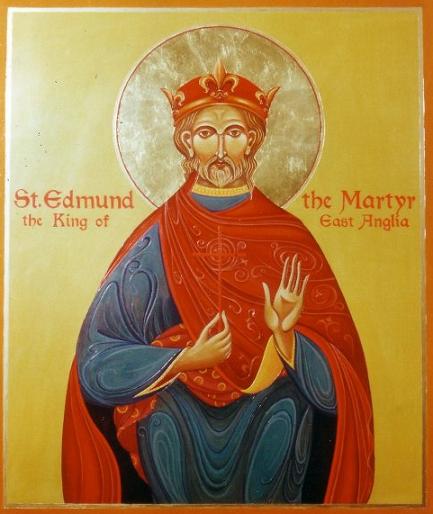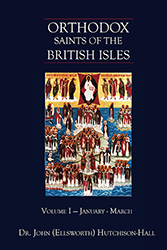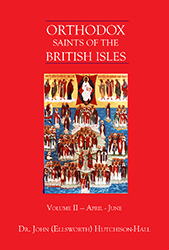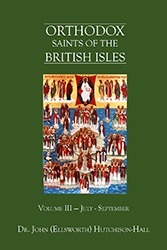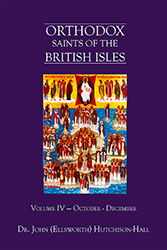
Orthodox Saints of the Pre-Schism
See of Rome
3rd December (NS) — 20th November (OS) 2023
AMPELUS and GAIUS, martyrs at Messina in Sicily during the Diocletianic Persecution (303–313).
AUTBODUS, an Irishman who evangelised in Hainault (present-day Belgium), Artois and Picardy (northern France). St. Autbodus spent the last years of his life as a hermit near Laon, Picardy (northern France), reposing 690.
BENIGNUS, little is known of this saint's life, save that he was consecrated the 21st Archbishop of Milan (north-west Italy) in 465 and served until his repose circa 477.
BERNWARD (BERWARD), fourteenth Bishop of Hildesheim (Lower Saxony) from 993 until his repose in 1022. In addition to his piety, St. Bernward was noted for his skill in mathematics, painting, architecture, and particularly in the manufacture of ecclesiastical vessels. He spent his early years as chaplain at the imperial court, and even served as tutor to Otto III, Holy Roman Emperor (r. 996–1002). St. Bernward reposed 1022.
EDMUND, the first patron saint of England, and a king of the East Angles who was martyred whilst defending his kingdom from Danish invaders. Nothing certain is known of his lineage and early years, though many spurious legends arose which were held to be valid by many. Unfortunately, since the Viking sack of East Anglia seems to have destroyed most of the records extant at the time, there is no contemporary East Anglian documentation of King St. Edmund’s life or reign. King St. Edmund was martyred when he refused to subjugate himself to the pagan Vikings who then had him beaten, scourged, and finally beheaded. A group of Christians buried King St. Edmund at the place now known as Bury St. Edmund, and a simple chapel was built over his grave. Later a substantial church was built in his honour, and when translating his relics to this church, they were found to be not only incorrupt, but his skin was still soft and fresh, and his head reattached with only a thin line around his neck where he had been decapitated. King St. Edmund’s shrine rapidly became one of the most frequented pilgrimage sites in England, and was richly endowed by various kings of England over the centuries. Thus, by the end of the twelfth century the abbey of Bury St. Edmunds had become one of the wealthiest, and most advantaged monasteries in England. In 1539, during the Dissolution of the Monasteries in England and Wales (1536–1540) by Henry VIII, King of England and Ireland, (r. 1509–1547), King St. Edmund’s shrine was sacked, the Abbot and monks expelled, and the abbey dissolved. Though originally the patron saint of England, King St. Edmund was replaced by St. George the Trophy-bearer (23rd April) by King Edward III (r. 1327 – 1377) when King Edward took St. George as patron of the Order of the Garter. In addition to his feast on 20th November, the Moscow Patriarchate’s calendar lists the translation of his relics on 30th March.
EUDO (EUDON, EUDES ODO), a monk at the Abbey of Our Lady of Lérins (abbaye Notre Dame de Lérins) on one of the Lérins Islands in the Mediterranean Ocean off the Côte d’Azur in France, and Abbot-founder of Corméry-en-Velay Abbey (later called Saint-Chaffre). St. Eudo reposed circa 760.
EVAL (UVOL, URFOL), (Sixth Century), a bishop in Cornwall for whom the civil parish and hamlet in north Cornwall, England is named. Nothing certain is known of his life, but he is believed to have lived at the end of the sixth century.
LEO of NONANTULA, an Abbot of Nonantula Abbey near Modena in the Emilia-Romagna region of northern present-day Italy, who reposed in 1000.
MAXENTIA, (Date Unknown), an Irish (or Scottish) woman who fled to the Continent to escape marriage to a pagan chieftain. Once there she became an anchoress near Senlis in Picardy (northern France). Unfortunately, the chieftain eventually located St. Maxentia and beheaded her at Pont-Sainte-Maxence in present-day Nord-Pas-de-Calais-Picardie (northern France).
OCTAVIUS, SOLUTOR, and ADVENTOR, members of the Theban Legion who were amongst those who managed to escape the initial slaughter ordered by Maximian Herculeus. SS. Octavius, Solutor, and Adventor managed to reach Turin before being captured and executed (297). SS. Octavius, Solutor, and Adventor are the patron saints of Turin.
SILVESTER, Bishop of Châlon-sur-Saône, in the present-day region of Bourgogne-Franche-Comté in eastern France from circa 484 until his repose circa 525. He was described as 'the glory of confessors' by St. Gregory of Tours (17th November).
SIMPLICIUS of VERONA, traditionally purported to have been a Bishop of Verona (northern Italy), though there is a lack of verifiable information on his life, and he has been deleted from recent martyrologies. St. Simplicius is believed to have reposed circa 535.
ABBO, an Abbot of the Abbey of Saint-Germain d'Auxerre in Burgundy. St. Abbo was consecrated Bishop of Auxerre in 857, however, after two years he resigned his See to spend the rest of his life as a monk. He reposed circa 860.
AGRICOLA, (Date Unknown), a martyr in Hungary, who although there are no lives extant, he is listed in all the ancient martyrologies.
ATTALIA (ATTALA), one of the three daughters of Adalbert, Duke of Alsace, and a niece of St. Odilia (13th December). St. Attalia was a nun who was appointed first Abbess of the Abbey of St. Stephen in Strasbourg. St. Attalia reposed in 741.
BIRINUS, a native of Lombardy, consecrated Bishop by Asterius Bishop of Genoa, and then sent by Pope Honorius to convert the West Saxons. One of his earliest converts was Cynegils, King of Wessex, at whose baptism King St. Oswald of Northumbria (5th August) served as godfather. St. Birinus founded the Diocese of Dorchester in Oxfordshire where reposed circa 650. His relics were translated to the Church of St. Peter at Winchester by Bishop Hedda in 686. St. Birinus is also known as the Apostle of Wessex.
CASSIAN, a court recorder at the trial of St. Marcellus (30th October) at Tangiers (298). When the sentence of death was handed down, St. Cassian, decrying the court’s decision, and revealed himself to be a Christian. He was rewarded with arrest and soon after martyrdom.
CLAUDIUS, CRISPIN, MAGINA, JOHN, and STEPHEN, (Date Unknown), martyrs in North Africa, of whom nothing is known.
ELOQUE (ELOQUIUS), a disciple of St. Fursey (16th January) and later Abbot of the Abbey of Saint-Pierre de Lagny. St. Eloquius reposed circa 666.
ETHERNAN, (Date Uncertain), a Scot who studied in Ireland where, in time, he was consecrated bishop. He then returned to Scotland where he devoted the rest of his life spreading the Gospel. His Feast and Office were in the Aberdeen Breviary.
LUCIUS, (Second Century), In the Liber Pontificalis’ (c. 6th century) biography of Pope St. Eleutherius (26th May) is the following brief sentence: ‘He received a letter from Lucius, a British king, who wanted to become a Christian on his authority’. From this developed the tradition of King St. Lucius, a British king who requested missionaries from the Pope of Rome. For centuries after, this legend of the “first Christian king of Britain” was widely considered an accurate account of Christianity among the early Britons. And while it has been argued that this is the only explanation for the existence of an organised British church in Roman times, there is no contemporary evidence that King St. Lucius ever lived. Modern scholars generally follow the argument of German theologian and church historian Adolf von Harnack († 1930) who suggested that the statement in the Liber Pontificalis is due to a transcription error. As the Middle Ages progressed the legend of King St. Lucius grew more and more elaborate. According to the Roman Martyrology St. Lucius abdicated his throne, became a missionary, and served as the first Bishop of Chur, in the present-day Canton of Graubünden, Switzerland. Various versions of the legend of King St. Lucius appeared in the Historia Brittonum (early 9th century), William of Malmesbury’s Gesta Pontificum Anglorum (early 12th century), and the Book of Llandaff (also early 12th century). However, it was Geoffrey of Monmouth’s early 12th century chronicle, Historia Regum Britanniae, which stands out as the most historically significant account of the life of St. Lucius, in which Geoffrey stresses the saint’s virtues, and provides a detailed, albeit mythical, story of Christianity’s growth in Britain during St. Lucius’ reign. This account remained the exemplar until well into the 20th century, when historians pointed out the unlikeliness of a British king south of Hadrian’s Wall in the second century, and certainly none who would have been in the position to send a delegation to the Pope. King St. Lucius is generally believed reposed circa 156 at Gloucester, though there is said to have been a plaque in the church of St. Peter upon Cornhill in the City of London (destroyed in the Great Fire 1666), crediting St. Lucius with founding of that church in 179. What are said to be St. Lucius’ relics are enshrined in the Cathedral of St. Luzius in Chur, although scholarly consensus is that the See only dates from the early fourth century.
MIROCLES, the seventh Bishop of Milan. St. Mirocles he was Bishop when Emperor Saint Constantine the Great (21st May) issued the Edict of Milan, and is also recorded as being present at the Lateran Council of 313, as well as the Synod of Arles of 314 which condemned Donatism. In addition he helped in the development of the Liturgy and Chant of the Ambrosian Rite. St. Mirocles reposed circa 316, later his life and work were praised by St. Ambrose of Milan (7th December).
SOLA (SOL, SOLUS, SUOLO), an English monk who went to Germany where he became a disciple of St. Boniface (5th June) who later ordained him to the priesthood. St. Sola then lived as a hermit near Fulda in Hesse, then near Eichstätt in Bavaria. At each, St. Sola attracted disciples. The number of disciples at Eichstätt were so great that he founded an abbey at Solnhofen for them where he spent the rest of his life. St. Sola reposed in 794.
Prior to the Schism the Patriarchate of Rome was Orthodox, and fully in communion with the Orthodox Church. As Saint John of Shanghai and San Francisco +1966 said “The West was Orthodox for a thousand years, and her venerable Liturgy is far older than any of her heresies”.
Details of British Saints excerpted from Orthodox Saints of the British Isles.
Details of continental saints from these sources.
In many cases there are several spelling versions of the names of saints from the British Isles. I use the Oxford Dictionary of National Biography version as the primary version with the more prevalent version in parenthesis e.g. Ceadda (Chad) of Lichfield.
